
 |
||||||
|
GAY
FILM REVIEWS BY MICHAEL D. KLEMM
|
||||||
|
Mala Noche Criterion Collection,
Screenplay: Starring: Unrated, 78 minutes
My Own Private Idaho Criterian
Collection, Director:
Screenplay:
Starring:
Rated R, 104 minutes |
My
Own Private Oregon
Mala Noche (1985), renowned director Gus Van Sant's first film, launched a career that includes My Own Private Idaho and Milk. Queer films were just emerging in those days and Mala Noche, sadly, never had much of a release. That same year it was overshadowed by two other groundbreakers; My Beautiful Laundrette and Kiss Of The Spider Woman. Until two years ago, Mala Noche had never been available on home video, despite always being included in documentaries about queer films. This crime against cinema was finally repaired with a stunning Criterion DVD, featuring a superb transfer, of Van Sant's freshman foray into filmmaking. |
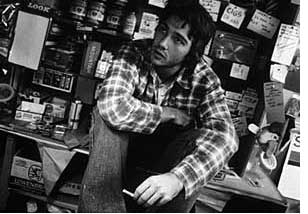 Based
on a 1977 cult novella by Oregon author, Walt Curtis, Mala
Noche is a black
& white Film Noir filtered through Jack Kerouac and the Beats. Tim Streeter
plays Walt, a lusty and overly romantic liquor store clerk. He is unable
to take his eyes off of Johnny (Doug Cooeyate), a young immigrant who hopped
a train to Portland with some friends. "I want to drink this Mexican boy,"
his thoughts trumpet to the audience, "He makes my heart throb when I see
him. Thumpitty bump bump bump." Based
on a 1977 cult novella by Oregon author, Walt Curtis, Mala
Noche is a black
& white Film Noir filtered through Jack Kerouac and the Beats. Tim Streeter
plays Walt, a lusty and overly romantic liquor store clerk. He is unable
to take his eyes off of Johnny (Doug Cooeyate), a young immigrant who hopped
a train to Portland with some friends. "I want to drink this Mexican boy,"
his thoughts trumpet to the audience, "He makes my heart throb when I see
him. Thumpitty bump bump bump." |
|
|
|
|
|
|
|
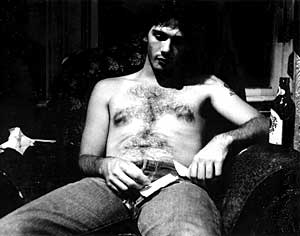 It
is suggested that the boys could be underaged, but the ages of Johnny
and his pals are never known for sure. Walt tells Betty that Johnny "says
he's eighteen." It hardly matters because the boys are in charge; they know
that Walt is at their beck and call and they take advantage at every opportunity.
Walt isn't quite as pathetic as he sounds. His ineptitude has a charm of
its own and his clumsiness eventually becomes enduring. He does nothing
right. One night he climbs a fire escape to Johnny's room, only to find
that Johnny is gone and a screaming Mexican woman, who thinks he's from
Immigration, resides there now. It's easier to identify with someone who
isn't Don Juan and Walt blows it every time. Van Sant wisely cast
a young actor as Walt to avoid the more unsavory air of "a dirty old man." It
is suggested that the boys could be underaged, but the ages of Johnny
and his pals are never known for sure. Walt tells Betty that Johnny "says
he's eighteen." It hardly matters because the boys are in charge; they know
that Walt is at their beck and call and they take advantage at every opportunity.
Walt isn't quite as pathetic as he sounds. His ineptitude has a charm of
its own and his clumsiness eventually becomes enduring. He does nothing
right. One night he climbs a fire escape to Johnny's room, only to find
that Johnny is gone and a screaming Mexican woman, who thinks he's from
Immigration, resides there now. It's easier to identify with someone who
isn't Don Juan and Walt blows it every time. Van Sant wisely cast
a young actor as Walt to avoid the more unsavory air of "a dirty old man." |
|
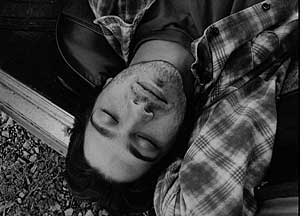 Mala
Noche
feels like a Beat Generation novel. The same raw sense of spontaneity and
jazz rhythms are shared; Walt Curtis hung out with many of the Beats and
there is a definite crossover in styles to both the film and its source
material. Curtis also knew Ken Kesey, the more famous author associated
with Oregon (who also put his own spin on the Beat tradition for the 1960s) and
the film version of Kesey's One Flew Over the Cuckoo's Nest - specifically
its background score - is evoked as a sad version of "Home On The Range"
is played on a saw. The Oregon setting, also Van Sant's home, is a character
in its own right. Mala
Noche
feels like a Beat Generation novel. The same raw sense of spontaneity and
jazz rhythms are shared; Walt Curtis hung out with many of the Beats and
there is a definite crossover in styles to both the film and its source
material. Curtis also knew Ken Kesey, the more famous author associated
with Oregon (who also put his own spin on the Beat tradition for the 1960s) and
the film version of Kesey's One Flew Over the Cuckoo's Nest - specifically
its background score - is evoked as a sad version of "Home On The Range"
is played on a saw. The Oregon setting, also Van Sant's home, is a character
in its own right. |
|
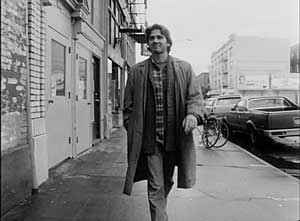 Many
of Van Sant's films channel the Beats and he is a kindred spirit. He collaborated
on a few short films with queer Beat writer William S. Burroughs (Naked
Lunch - 1959) and, in an inspired piece of casting, hired Burroughs
to play a junkie ex-priest in his next film, Drugstore Cowboys (1989).
The images of Walt walking the dirty streets in an overcoat could easily
have been a pulp paperback cover of Burrough's Junky (1953) - similar
photographs of James Dean are also recalled. Van Sant's influences are certainly
mined from maverick and adventurous territory. Think On The Road, but
rewritten so Sal Paradise has sex with Dean Moriarity. Many
of Van Sant's films channel the Beats and he is a kindred spirit. He collaborated
on a few short films with queer Beat writer William S. Burroughs (Naked
Lunch - 1959) and, in an inspired piece of casting, hired Burroughs
to play a junkie ex-priest in his next film, Drugstore Cowboys (1989).
The images of Walt walking the dirty streets in an overcoat could easily
have been a pulp paperback cover of Burrough's Junky (1953) - similar
photographs of James Dean are also recalled. Van Sant's influences are certainly
mined from maverick and adventurous territory. Think On The Road, but
rewritten so Sal Paradise has sex with Dean Moriarity. |
|
|
Mala Noche is especially interesting as we watch Van Sant's emerging style. With few exceptions (his inexplicable and pointless remake of Hitchcock's Psycho for one), Van Sant would rarely stray from his passion for those on the margins, on the fringe of society. Judgment is never passed, be the characters hustlers, immigrants, savants, addicts who rob pharmacies, or homosexuals. Walt is not a conventional hero, and was certainly atypical in 1985. |
|
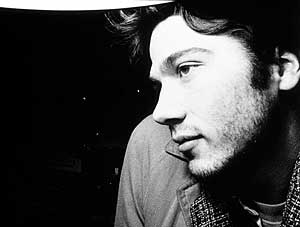 Without
question, this film broke much new ground. Usually, when writing about queer
faire from the early to mid 1980s, it is common to "ooh" and "ahh" over
two men sharing a kiss. We see much more than that in Mala
Noche. Walt's full frontal nudity is surprising, as is the
amount of intimacy shown when he brings Pepper home. Walt is actually allowed
to get laid. Their sex seems, for the time, explicit but much of it is extreme
close-ups, rapidly cut together. You don't see the mechanics but you know
what they are doing - especially when Walt tells Pepper to slow down and
then goes into the bathroom to grab a jar of Vaseline. The sounds of distant
trains, rather than distracting music, adds to the hot, yet haunting, scene's
effectiveness. There is also much homoerotic horseplay between Johnny and
his friends, not to mention gratuitous beefcake. While not a masterpiece,
Mala Noche was quite a gutsy
film in its day. Without
question, this film broke much new ground. Usually, when writing about queer
faire from the early to mid 1980s, it is common to "ooh" and "ahh" over
two men sharing a kiss. We see much more than that in Mala
Noche. Walt's full frontal nudity is surprising, as is the
amount of intimacy shown when he brings Pepper home. Walt is actually allowed
to get laid. Their sex seems, for the time, explicit but much of it is extreme
close-ups, rapidly cut together. You don't see the mechanics but you know
what they are doing - especially when Walt tells Pepper to slow down and
then goes into the bathroom to grab a jar of Vaseline. The sounds of distant
trains, rather than distracting music, adds to the hot, yet haunting, scene's
effectiveness. There is also much homoerotic horseplay between Johnny and
his friends, not to mention gratuitous beefcake. While not a masterpiece,
Mala Noche was quite a gutsy
film in its day. |
|
|
The Criterion DVD also includes a lengthy interview with Van Sant, as well as a 1997 documentary about Curtis, entitled Walt Curtis, The Peckerneck Poet.
|
|
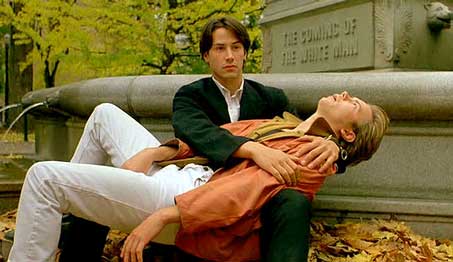 |
|
| Mala Noche caught the attention of several studios and Van Sant found himself being courted with movie offers. When asked what film he would like to make, he described the story of My Own Private Idaho... to which each studio head responded: what else have you got? | |
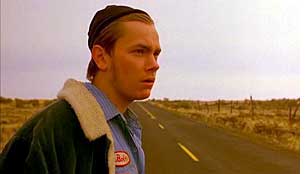 The
subsequent success of Drugstore Cowboy (1989) enabled Van Sant to
make My Own Private Idaho (1991).
Queer films weren't exactly a dime a dozen in those days and there was a
lot of buzz surrounding the film prior to its release. Much of the buzz
was, like Brokeback Mountain a decade
later, centered around the casting of two hot young rising stars who were
(gasp!) "risking their careers" by playing gay in a movie when they should
have remained teen idols instead - Keanu Reeves and the late River Phoenix.
(Queer rumors would follow Reeves for years, most notably the bizarre urban
legend that he married out producer David Geffen.) The
subsequent success of Drugstore Cowboy (1989) enabled Van Sant to
make My Own Private Idaho (1991).
Queer films weren't exactly a dime a dozen in those days and there was a
lot of buzz surrounding the film prior to its release. Much of the buzz
was, like Brokeback Mountain a decade
later, centered around the casting of two hot young rising stars who were
(gasp!) "risking their careers" by playing gay in a movie when they should
have remained teen idols instead - Keanu Reeves and the late River Phoenix.
(Queer rumors would follow Reeves for years, most notably the bizarre urban
legend that he married out producer David Geffen.) |
|
| My Own Private Idaho is many things.. It is John Rechy's City Of Night crossed with the Beats, perhaps a Sam Shepard play, and re-set in Portland. It a revisionist Western, it is a road movie, it is an update of Shakespeare's Henry IV Part One. Finally, it is a new Midnight Cowboy for the 90s in which the queer dimension is decidedly more visible. | |
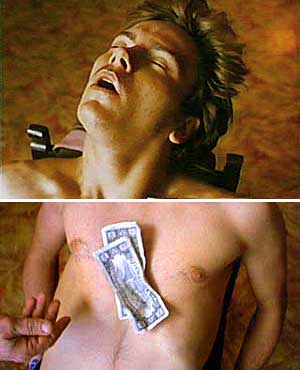 The
movie opens with the definition of Narcolepsy in a dictionary. Mike Waters
(Phoenix) is a young hustler who suffers from this condition; at times of
stress he is unable to keep from falling into a deep sleep. As the film
begins, Mike is standing on the side of a barren country road in Idaho.
He knows this road, he has seen it before, it is his road. There
is a "fucked up face" in the landscape and the camera narrows into a iris
to show it to us. The panoramic shots of Mike dwarfed by the empty road
carry an air of menace, all the more so because the shots are so reminiscent
of the crop-dusting plane scene in Hitchcock's
North By Northwest. Mike suffers an attack and falls asleep in the
middle of the road. He imagines his lost mother, time lapse clouds rush
past in the sky, a country song croons on the soundtrack, a kitschy giant
cowboy statue smiles down at the camera. The film's titles are interspersed.
Cut to a close-up of Mike's face, twitching and then moaning. Is he still
collapsed on the road? No, the camera pulls back and he is leaning back
in a chair while being fellated by a john in a hotel room. His orgasm is
accompanied by the bizarre image of a barn crashing into the middle of his
road. The
movie opens with the definition of Narcolepsy in a dictionary. Mike Waters
(Phoenix) is a young hustler who suffers from this condition; at times of
stress he is unable to keep from falling into a deep sleep. As the film
begins, Mike is standing on the side of a barren country road in Idaho.
He knows this road, he has seen it before, it is his road. There
is a "fucked up face" in the landscape and the camera narrows into a iris
to show it to us. The panoramic shots of Mike dwarfed by the empty road
carry an air of menace, all the more so because the shots are so reminiscent
of the crop-dusting plane scene in Hitchcock's
North By Northwest. Mike suffers an attack and falls asleep in the
middle of the road. He imagines his lost mother, time lapse clouds rush
past in the sky, a country song croons on the soundtrack, a kitschy giant
cowboy statue smiles down at the camera. The film's titles are interspersed.
Cut to a close-up of Mike's face, twitching and then moaning. Is he still
collapsed on the road? No, the camera pulls back and he is leaning back
in a chair while being fellated by a john in a hotel room. His orgasm is
accompanied by the bizarre image of a barn crashing into the middle of his
road. |
|
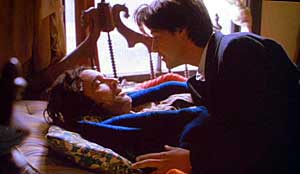 This
was a quite an evocative and daring (for its time) way to begin a very unconventional
movie. The bulk of My Own Private Idaho
follows the adventures of two hustlers, Mike and his best friend Scott Favor
(Reeves). Scott is actually the Mayor of Portland's son, and this is where
Shakespeare's Henry IV comes in. Scott, like the Bard's Prince Hal,
angers his father (the King/Mayor) by slumming it as a street vagabond until
he comes into his inheritance. Furthering the Globe Theatre connection is
the fatherly love Scott feels for Bob Pigeon (William Richert), a petty
thief who is the mentor of a gang of street criminals and hustlers. "Fat
Bob" is, of course, based on Shakespeare's beloved Falstaff, only in this
case the drunken knight is also queer. Scott, like Prince Hal, will also
break his Falstaff's heart when he turns 21, returns to the life that he
was groomed for, and rejects his surrogate father. This
was a quite an evocative and daring (for its time) way to begin a very unconventional
movie. The bulk of My Own Private Idaho
follows the adventures of two hustlers, Mike and his best friend Scott Favor
(Reeves). Scott is actually the Mayor of Portland's son, and this is where
Shakespeare's Henry IV comes in. Scott, like the Bard's Prince Hal,
angers his father (the King/Mayor) by slumming it as a street vagabond until
he comes into his inheritance. Furthering the Globe Theatre connection is
the fatherly love Scott feels for Bob Pigeon (William Richert), a petty
thief who is the mentor of a gang of street criminals and hustlers. "Fat
Bob" is, of course, based on Shakespeare's beloved Falstaff, only in this
case the drunken knight is also queer. Scott, like Prince Hal, will also
break his Falstaff's heart when he turns 21, returns to the life that he
was groomed for, and rejects his surrogate father. |
|
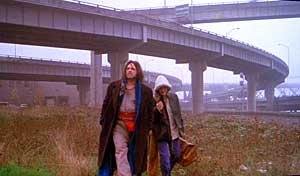 Using
Shakespeare (and also the classic Orson Welles film about Falstaff, Chimes
At Midnight) provides a unique structure and an anchor to what would
otherwise be a very episodic road movie. Scott's search for a father figure
is complimented by Mike's search for the mother who abandoned him. This
journey will take the lads from Portland to Idaho, and then to Italy and
back again. Using
Shakespeare (and also the classic Orson Welles film about Falstaff, Chimes
At Midnight) provides a unique structure and an anchor to what would
otherwise be a very episodic road movie. Scott's search for a father figure
is complimented by Mike's search for the mother who abandoned him. This
journey will take the lads from Portland to Idaho, and then to Italy and
back again. |
|
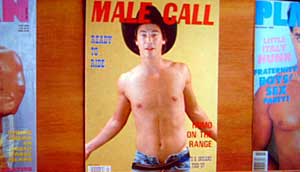 Scott
delivers a contemporary soliloquy from the cover of a porn magazine to clarify
that he is not queer but, as a hustler, he isn't picky what sex his clients
are as long as they can pay. Mike, however, is in love with Scott. This
heir apparent might be gay for pay but he also harbors deep feelings of
friendship for Mike. Scott is often seen taking care of his sleeping friend
when the Narcoleptic fits incapacitate him. One such scene, in which Scott
cradles Mike beneath a Portland fountain, resembles a pieta. These scenes
are very touching, as are the moments shared between Scott and Fat Bob.
"He is my true father," Scott orates in streetwise iambic pentameter. Scott
delivers a contemporary soliloquy from the cover of a porn magazine to clarify
that he is not queer but, as a hustler, he isn't picky what sex his clients
are as long as they can pay. Mike, however, is in love with Scott. This
heir apparent might be gay for pay but he also harbors deep feelings of
friendship for Mike. Scott is often seen taking care of his sleeping friend
when the Narcoleptic fits incapacitate him. One such scene, in which Scott
cradles Mike beneath a Portland fountain, resembles a pieta. These scenes
are very touching, as are the moments shared between Scott and Fat Bob.
"He is my true father," Scott orates in streetwise iambic pentameter. |
|
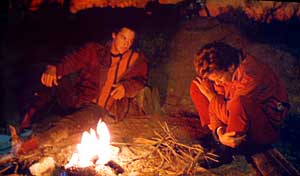 The
pivotal episode occurs at night by a campfire. A flood of emotion is released
during this legendary scene, which was improvised by River Phoenix. Mike,
clutching his knees in almost a fetal position, awkwardly confesses his
love. Scott insists that two men can't love one another; he can only do
it for money. Scott finally hugs Mike, and holds him by the fire, but we
never discover if this moment of affection goes any further. The scene evokes
countless confessional campfires from Westerns in which two cowboys would
share their pasts or their darkest secrets. Critic Leslie Fiedler famously
wrote about hidden and coded homosexuality in Westerns and director Van
Sant brings this right out into the forefront during his campfire
scene. My Own Private Idaho,
until Brokeback Mountain, was the boldest
such statement to occur in all of cinema. The
pivotal episode occurs at night by a campfire. A flood of emotion is released
during this legendary scene, which was improvised by River Phoenix. Mike,
clutching his knees in almost a fetal position, awkwardly confesses his
love. Scott insists that two men can't love one another; he can only do
it for money. Scott finally hugs Mike, and holds him by the fire, but we
never discover if this moment of affection goes any further. The scene evokes
countless confessional campfires from Westerns in which two cowboys would
share their pasts or their darkest secrets. Critic Leslie Fiedler famously
wrote about hidden and coded homosexuality in Westerns and director Van
Sant brings this right out into the forefront during his campfire
scene. My Own Private Idaho,
until Brokeback Mountain, was the boldest
such statement to occur in all of cinema. |
|
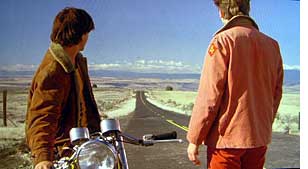 The
Western themes register repeatedly... the images of the open road, Scott
wearing a cowboy hat on that porn magazine cover, a hyperactive hustler
posing as Billy the Kid with a pair of pistols. Road movies from Hope and
Crosby to Easy Rider are recalled. The influence of Shakespeare has
already been discussed. Van Sant even channels a bit of Stanley Kubrick
in the mise-en-scene and color schemes of several interiors, as well as
the film's titles which mimic the credits to A Clockwork Orange. The
Western themes register repeatedly... the images of the open road, Scott
wearing a cowboy hat on that porn magazine cover, a hyperactive hustler
posing as Billy the Kid with a pair of pistols. Road movies from Hope and
Crosby to Easy Rider are recalled. The influence of Shakespeare has
already been discussed. Van Sant even channels a bit of Stanley Kubrick
in the mise-en-scene and color schemes of several interiors, as well as
the film's titles which mimic the credits to A Clockwork Orange.
|
|
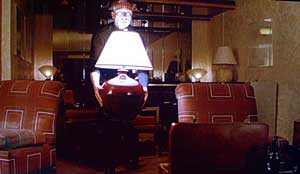 Despite
these rich traditions from literature and cinema that Van Sant brings to
My Own Private Idaho, the film
is hardly a dry exercise and the director doesn't forget to be funny. For
example, it shares with Midnight Cowboy, and almost all other hustler
movies ever made, an assortment of eccentric and sometimes repulsive johns
to add comic relief. Mike goes home with an elderly clean-freak who dances
like Fred Astaire and then strips to an old Rudy Vallee recording from the
1920s while Mike, dressed as the Little Dutch Boy, scrubs his apartment.
There's also the German, Hans - who has this "now's the time on Sprockets
ven ve dance!" moment as he entertains our boys while prancing around
with a large lamp that lights his face from below as he lip-synchs to a
Teutonic techno tape. Their subsequent threeway becomes a comic tableaux
as the participants freeze in absurd sexual positions, some with handcuffs.
Some of the humor is more subtle - Fat Bob's modern Falstaff attire includes
a bathrobe and a codpiece. Despite
these rich traditions from literature and cinema that Van Sant brings to
My Own Private Idaho, the film
is hardly a dry exercise and the director doesn't forget to be funny. For
example, it shares with Midnight Cowboy, and almost all other hustler
movies ever made, an assortment of eccentric and sometimes repulsive johns
to add comic relief. Mike goes home with an elderly clean-freak who dances
like Fred Astaire and then strips to an old Rudy Vallee recording from the
1920s while Mike, dressed as the Little Dutch Boy, scrubs his apartment.
There's also the German, Hans - who has this "now's the time on Sprockets
ven ve dance!" moment as he entertains our boys while prancing around
with a large lamp that lights his face from below as he lip-synchs to a
Teutonic techno tape. Their subsequent threeway becomes a comic tableaux
as the participants freeze in absurd sexual positions, some with handcuffs.
Some of the humor is more subtle - Fat Bob's modern Falstaff attire includes
a bathrobe and a codpiece. |
|
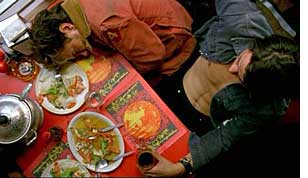 The
film's approach is episodic with various peaks, both dramatic and comic,
scattered throughout. Things get a little heavy when Scott offers to help
Mike find his mother. Leaving Portland behind, they head to Idaho to see
Mike's brother. Along the way their motorcycle breaks down - on that same
road from the opening scene - followed by the confessional campfire scene.
At his brother's trailer, Mike demands to know who his real father is and
the resulting confrontation, worthy of a Shepard play, is one where neither
can handle the truth. The trail eventually leads to Italy and two devastating
blows for Mike. The
film's approach is episodic with various peaks, both dramatic and comic,
scattered throughout. Things get a little heavy when Scott offers to help
Mike find his mother. Leaving Portland behind, they head to Idaho to see
Mike's brother. Along the way their motorcycle breaks down - on that same
road from the opening scene - followed by the confessional campfire scene.
At his brother's trailer, Mike demands to know who his real father is and
the resulting confrontation, worthy of a Shepard play, is one where neither
can handle the truth. The trail eventually leads to Italy and two devastating
blows for Mike. |
|
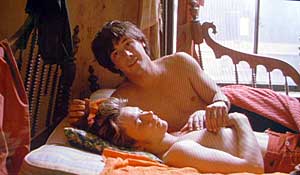 It's
interesting to note that, while improvising the campfire interlude, Phoenix
decided to make explicit what was only implied in the original script and
declared his love openly to Scott. With Mike firmly identified as queer,
we are left with the ambiguous sexuality of his best friend. When Scott
falls in love with an Italian girl, their love scene is also composed, like
the threeway with Hans, with frozen tableaux. By equating this moment with
the earlier scene's silliness, can we surmise that he really just wants
her as a trophy wife to go along with his new position of privilege? His
previous relationship with Mike was teasingly homoerotic. Our Prince Hal
continually showed compassion and charity to Mike. During one comic sequence,
a police raid finds Scott in bed, playacting with Mike. Scott pulls Mike's
nipple and Mike playfully slaps his friend's hand. When Scott confronts
his real father, he is shirtless under a tight vest and wears a dog collar
around his neck. It is also certainly implied that there may have been a
relationship between Scott and his Falstaff. Bob, of course, is in love
with Scott. At one point Bob actually kisses Scott on the mouth. Yet Scott
can betray both of the men who love him and the climax of this theme sure
packs an emotional wallop. It's
interesting to note that, while improvising the campfire interlude, Phoenix
decided to make explicit what was only implied in the original script and
declared his love openly to Scott. With Mike firmly identified as queer,
we are left with the ambiguous sexuality of his best friend. When Scott
falls in love with an Italian girl, their love scene is also composed, like
the threeway with Hans, with frozen tableaux. By equating this moment with
the earlier scene's silliness, can we surmise that he really just wants
her as a trophy wife to go along with his new position of privilege? His
previous relationship with Mike was teasingly homoerotic. Our Prince Hal
continually showed compassion and charity to Mike. During one comic sequence,
a police raid finds Scott in bed, playacting with Mike. Scott pulls Mike's
nipple and Mike playfully slaps his friend's hand. When Scott confronts
his real father, he is shirtless under a tight vest and wears a dog collar
around his neck. It is also certainly implied that there may have been a
relationship between Scott and his Falstaff. Bob, of course, is in love
with Scott. At one point Bob actually kisses Scott on the mouth. Yet Scott
can betray both of the men who love him and the climax of this theme sure
packs an emotional wallop. |
|
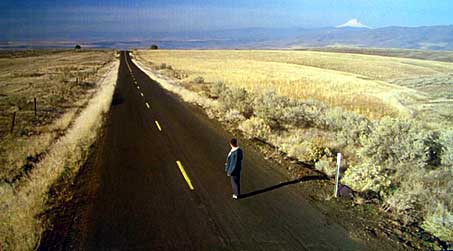 |
|
| The acting throughout is exceptional. Phoenix had already won acclaim as a teen in Mosquito Coast and (especially) Stand By Me. My Own Private Idaho was a major leap into the often terrifying territory of adult roles. Reeves was best known, at that point, for Bill And Ted's Excellent Adventure and so both actors were certainly entering unknown terrain here. Van Sant, again and again, knows when to trust his actors and Phoenix, at times, seems to be the reincarnation of James Dean as he fully inhabits his character and makes it his own. Richert's seedy and flamboyant Fat Bob is also a unique creation and he commands every scene in which he appears. | |
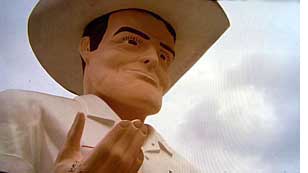 My
Own Private Idaho
shares, along with Mala Noche, an affection for its street characters
while exploring a tragicomic tale of unrequited love. It is also another
valentine to Portland. As noted in the earlier essay, Mala Noche
showcased the genesis of Van Sant's filmic style and a clear refinement
is evident in My Own Private Idaho.
The hallmarks are here again, the gritty realism contrasted with artsy images
to reflect interior states - the time lapse clouds, the jerky home movies,
the images of desolate roads. There is also an inspired use of music, coupled
with an artful respect for the power of silence. Sound is used effectively;
a background symphony that accompanies the campfire scene includes wind,
a train in the distance and quiet Native American chants. My
Own Private Idaho
shares, along with Mala Noche, an affection for its street characters
while exploring a tragicomic tale of unrequited love. It is also another
valentine to Portland. As noted in the earlier essay, Mala Noche
showcased the genesis of Van Sant's filmic style and a clear refinement
is evident in My Own Private Idaho.
The hallmarks are here again, the gritty realism contrasted with artsy images
to reflect interior states - the time lapse clouds, the jerky home movies,
the images of desolate roads. There is also an inspired use of music, coupled
with an artful respect for the power of silence. Sound is used effectively;
a background symphony that accompanies the campfire scene includes wind,
a train in the distance and quiet Native American chants. |
|
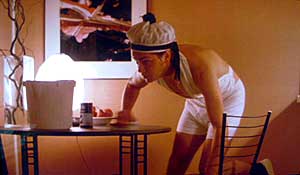 The
Criterion DVD is a must for anyone who appreciates this film. The bonus
disc's many extras includes a documentary, a lengthy audio interview between
Van Sant and fellow out filmmaker Todd Haynes (Poison, Far From Heaven),
and a handful of deleted scenes - two of them quite remarkable. Three of
these scenes were cut from the conclusion, all of them deemed expendable
by the director who desired a far more open ending. One identifies the man,
who stops on the road to pick up the sleeping Mike, as his brother. Another
shows Mike waking up in a hospital ward and trying to check himself out.
The interview includes many revelations surrounding the campfire scene and
we also learn that the crashing barn was based on an image that Van Sant
painted numerous times in his youth. The film transfer is, like the Mala
Noche disc, superb. The
Criterion DVD is a must for anyone who appreciates this film. The bonus
disc's many extras includes a documentary, a lengthy audio interview between
Van Sant and fellow out filmmaker Todd Haynes (Poison, Far From Heaven),
and a handful of deleted scenes - two of them quite remarkable. Three of
these scenes were cut from the conclusion, all of them deemed expendable
by the director who desired a far more open ending. One identifies the man,
who stops on the road to pick up the sleeping Mike, as his brother. Another
shows Mike waking up in a hospital ward and trying to check himself out.
The interview includes many revelations surrounding the campfire scene and
we also learn that the crashing barn was based on an image that Van Sant
painted numerous times in his youth. The film transfer is, like the Mala
Noche disc, superb. |
|
|
|
|
| More
On Gus Van Sant: Milk |